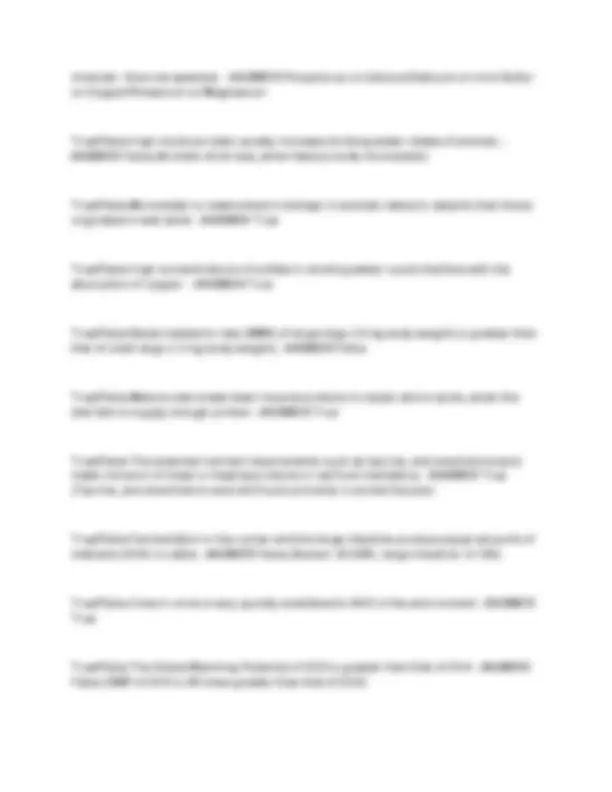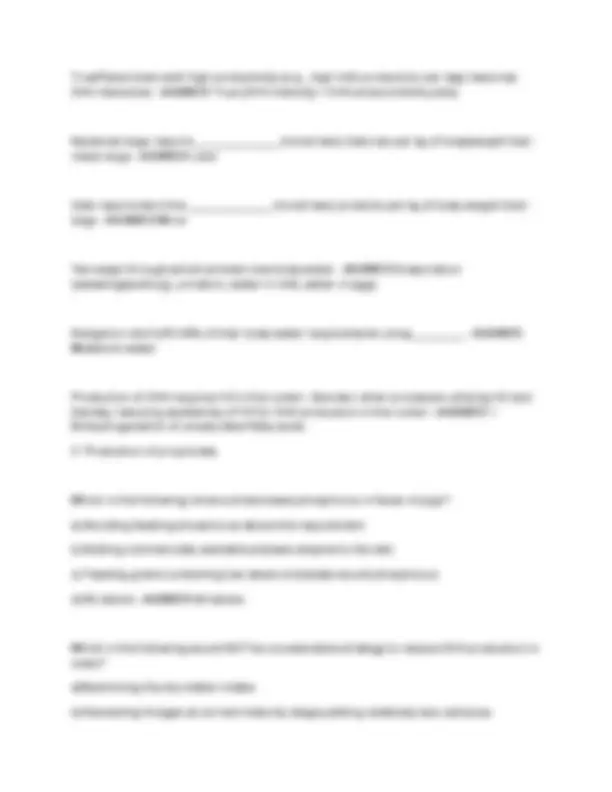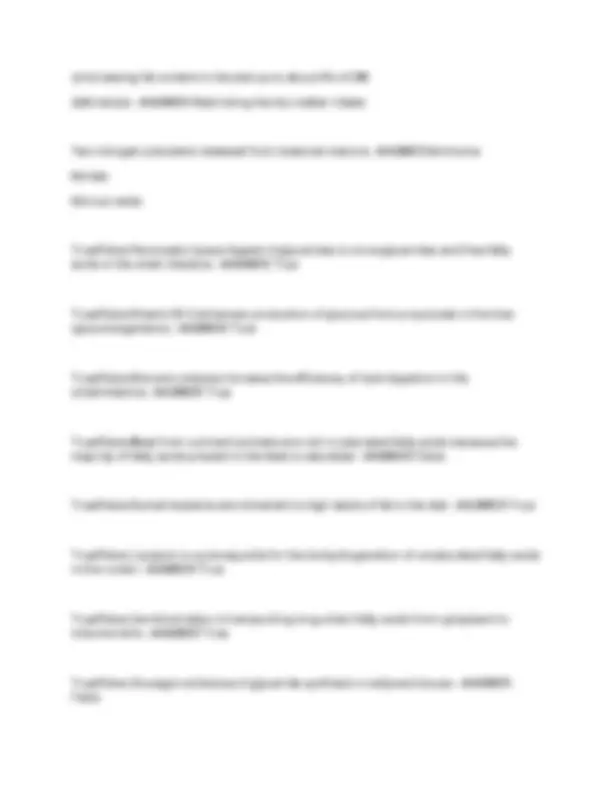





Study with the several resources on Docsity

Earn points by helping other students or get them with a premium plan


Prepare for your exams
Study with the several resources on Docsity

Earn points to download
Earn points by helping other students or get them with a premium plan
Community
Ask the community for help and clear up your study doubts
Discover the best universities in your country according to Docsity users
Free resources
Download our free guides on studying techniques, anxiety management strategies, and thesis advice from Docsity tutors
A series of true/false questions and answers related to animal nutrition and metabolism. It covers various aspects of animal physiology, including mineral requirements, vitamin deficiencies, water balance, energy metabolism, and nutrient digestion. The questions are designed to test understanding of key concepts and principles in animal science.
Typology: Exams
1 / 7

This page cannot be seen from the preview
Don't miss anything!




True/False Animals require larger amounts of copper in the diet than calcium - ANSWER False
True/False Rickets is common in adult animals and characterized by softening of bones - ANSWER False (common in young animals)
True/False Plants do not contain vitamin A but provide beta-carotene that could be converted to vitamin A in the body - ANSWER True
True/False Non-heme iron is more easily absorbed than heme-iron - ANSWER False (other way around)
True/False Cattle fed outdoors require less vitamin D in the diet than cattle fed indoors - ANSWER True
True/False Water soluble vitamins have a greater potential for toxicities thanfat soluble vitamins - ANSWER False (Should be the other way (Fat-soluble vitamins are accumulated in the body and cause toxicities)
True/False Phosphorus in grains and seeds are available more to ruminant animals than monogastric animals - ANSWER True
True/False The intracellular fluid volume is larger than the extracellular fluid volume in the body - ANSWER True
True/False Pigs are able to produce vitamin C from glucose in the body - ANSWER True
True/False Fat content in the body is negatively (inversely) related to water content in the body - ANSWER True
What is a symptom of calcium or vitamin D deficiency? - ANSWER Rickets/Osteomalacia/Osteoporosis
Of skin, liver, and kidney, where is the active form of Vitamin D3 produced? - ANSWER Kidney
Two ways, through which vitamins and minerals enhance utilization of other nutrients in the body - ANSWER 1. Enhancing absorption
The hormone enhancing water reabsorption from kidney in response to dehydration - ANSWER Antidiuretic hormone (ADH)
Grazing animals develop "grass tetany" due to low concentrations of this mineral in the blood - ANSWER Magnesium
Some lactating cows develop "milk fever" due to low concentrations of this mineral in the blood - ANSWER Calcium
An enzyme namely _________ breaks down phytate in grains and increases availability of phosphorus to animals - ANSWER Phytase
Give one property of water that helps the body maintain a constant temperature, when ambient temperature is too high - ANSWER High specific heat capacity/ high latent heat of evaporation
High concentration of some minerals in the diet interfere with the absorption of other
True/False Cows with high productivity (e.g., high milk production per day) have low CH4 intensities - ANSWER True (CH4 intensity = CH4 emission/milk yield)
Neutered dogs require _______________ (more/ less) Calories per kg of bodyweight than intact dogs - ANSWER Less
Cats require two time _______________ (more/ less) proteins per kg of body weight than dogs - ANSWER More
Two ways through which animals lose body water - ANSWER Evaporation (sweating/panting), urination, water in milk, water in eggs
Kangaroo rats fulfill 90% of their body water requirements using _________ - ANSWER Metabolic water
Production of CH4 requires H2 in the rumen. Give two other processes utilizing H2 and thereby reducing availability of H2 for CH4 production in the rumen - ANSWER 1. Biohydrogenation of unsaturated fatty acids
Which in the following list would decrease phosphorus in feces of pigs?
a) Avoiding feeding phosphorus above the requirement
b) Adding commercially available phytase enzyme to the diet
c) Feeding grains containing low levels of phytate-bound phosphorus
d) All above - ANSWER All above
Which in the following would NOT be a sustainable strategy to reduce CH4 production in cows?
a)Restricting the dry matter intake
b)Harvesting forages at correct maturity stage yielding relatively less cellulose
c)Increasing fat content in the diet up to about 6% of DM
d)All above - ANSWER Restricting the dry matter intake
Two nitrogen pollutants released from livestock manure - ANSWER Ammonia
Nitrate
Nitrous oxide
True/False Pancreatic lipase digests triglycerides to monoglycerides and free fatty acids in the small intestine - ANSWER True
True/False Vitamin B12 enhances production of glucose from propionate in the liver (gluconeogenesis) - ANSWER True
True/False Bile and colipase increase the efficiency of lipid digestion in the smallintestine - ANSWER True
True/False Meat from ruminant animals are rich in saturated fatty acids because the majority of fatty acids present in the feed is saturated - ANSWER False
True/False Rumen bacteria are intolerant to high levels of fat in the diet - ANSWER True
True/False Lipolysis is a prerequisite for the biohydrogenation of unsaturated fatty acids in the rumen - ANSWER True
True/False Carnitine helps in transporting long-chain fatty acids from cytoplasm to mitochondria - ANSWER True
True/False Glucagon enhances triglyceride synthesis in adipose tissues - ANSWER False
d)Strict carnivores produce a significant amount of glucose from amino acids - ANSWER The body prefers amino acids over glucose and fatty acids for the production of ATP